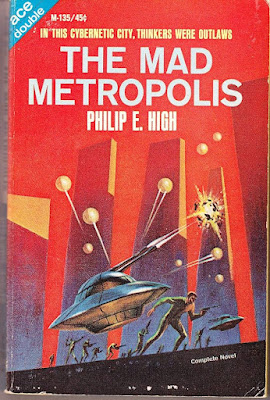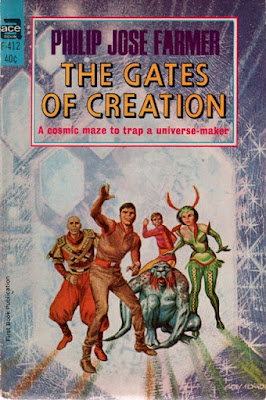Four for Tomorrow is the first story collection by Roger Zelazny, published in paperback by Ace Books in 1967. British hardcover and paperback editions followed in 1969, under the title A Rose for Ecclesiastes. The first American hardcover was issued in the Garland Library of Science Fiction in 1975.Though the novellas in this collection appear in numerous subsequent collections (in fact the entire contents of this book are included in the 2001 collection The Doors of His Face, the Lamps of His Mouth), this particular compendium stayed in print off and on for about 15 years. There’s great reading here, gang. Some readers today might find Zelazny’s often-florid prose stylings off-putting and pretentious — and they are at times, I’ll admit — but most of the time his work brought a rare beauty into the genre, as the saying goes, often imitated but never duplicated. There’s an introduction by Theodore Sturgeon to boot. The presence of both these late greats under one cover really brings it home what SF has lost. For absent friends, everyone...
THE FURIES ★★★★★
Spectacular tragic fable about a rebellious space captain pursued throughout the galaxy by three determined assassins with unique paranormal abilities. Often exquisitely clear storytelling, and Zelazny’s trademark fast pacing and sharp eye for making sympathetic and real characters even out of pure archetypes, carry this one right across the finish line. Funny and heart-wrenching in equal measure, its most impressive quality is the way Zelazny seems to have dashed it off so damn easily!
THE GRAVEYARD HEART ★★★★★
A brilliant engineer and ambitious social climber wangles himself acceptance into the Party Set, a clique of aristocrats who spend most of their lives in cold sleep, awakening only for days at a time to throw massive celebrations, and greatly extending their lifespans while decades go by in the outside world around them. Starts off as a rather amusing satire of the emptiness of wealth, high society and its “see-and-be-seen” ethos. Then it gradually morphs into something much deeper, as Zelazny examines the ramifications of how one fills the gap between who they really are and who they think they want to be, and how the very question of what is meaningful in life might be altered, or not, by such choices. Are those we envy the most really the most enviable? Poetic, dreamlike; a work of quiet profundity, utterly unique in SF.
THE DOORS OF HIS FACE, THE LAMPS OF HIS MOUTH ★★★★
Once there was a time when people thought Venus might hold tropical forests and vast oceans, and numerous SF tales embraced the concept (q.v. Poul Anderson's “Sister Planet”). This story is one of the more entertaining ones, winning a Nebula the first year they were given out. A thriving fishing industry on Venus lures the rich daughter of a cosmetics empire, and she hires her ex, now working as a “baitman,” to help her catch a leviathan-like creature that almost killed him the last time he went out after it. The story admirably skirts clichés involving whether they’ll reunite as a couple — indeed, Zelazny maintains a refreshingly cynical tone concerning their relationship — and he also goes out of his way not to make the giant fish a transparent metaphor for any great obstacle. (In other words, it’s not an SF pastiche on Moby-Dick.) But it’s a story rooted in character nonetheless, dealing with one’s need to set one’s own challenges and meet them. Fast-paced, too, and the setting is well-realized. The title is a reference to the description of Leviathan in chapter 41 of the Book of Job.
A ROSE FOR ECCLESIASTES ★★½
I don’t know that I can say honestly that this Hugo-nominated 1963 story has aged terribly well after all these years, and that’s not just because no one writes stories about intelligent humanoid civilizations on Mars any more. The story — about a poet laureate who saves the moribund Martian race from its own folly and gets a Martian girl pregnant into the bargain — still has the potential to be emotionally affecting, but Zelazny’s writing, with its nonstop literary allusions and poetic indulgences, comes off as extremely precious and pretentious to a contemporary sensibility. In other words, I liked the story, but didn’t care for its execution. Nevertheless, I can see how it would have made an impact in its day, even if Theodore Sturgeon waxes a bit hyperbolic in calling it “one of the most beautifully written, skillfully composed and passionately expressed works of art to appear anywhere, ever.” (Thomas M. Wagner, SFF180)

.jpg)







